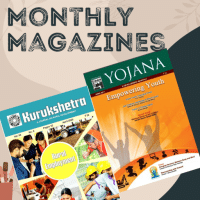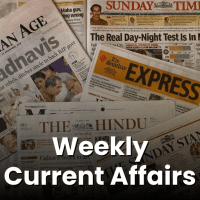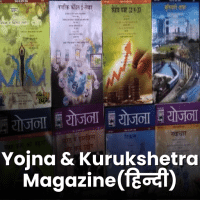Current Affairs Exam > Current Affairs Questions > Consider the following statements:1. The stat...
Start Learning for Free
Consider the following statements:
1. The state of Odisha accounts for the largest number of tribal population in India.
2. The central tribal belt extending from Rajasthan to West Bengal comprises the maximum concentration of indigenous population.
Which of the statements given above is/are correct?
- a)1 only
- b)2 only
- c)Both 1 and 2
- d)Neither 1 nor 2
Correct answer is option 'C'. Can you explain this answer?
Most Upvoted Answer
Consider the following statements:1. The state of Odisha accounts for ...
- India hosts around 104 million (that is almost 8.6% of the country’s population).
- Though there are 705 ethnic groups that have been formally identified, out of which around 75 are Particularly Vulnerable Tribal Groups (PVTGs).
- The Gond comprise the largest tribal group of India.
- The largest number of tribal communities (62) are found in Odisha. Hence, statement 1 is correct.
- The central tribal belt which comprises the Northeastern states of India (including the region ranging from Rajasthan to West Bengal) boasts of the maximum concentration of indigenous population. Hence, statement 2 is correct.
Free Test
FREE
| Start Free Test |
Community Answer
Consider the following statements:1. The state of Odisha accounts for ...
Statement 1: The state of Odisha accounts for the largest number of tribal population in India.
Statement 2: The central tribal belt extending from Rajasthan to West Bengal comprises the maximum concentration of indigenous population.
Explanation:
Statement 1: The state of Odisha accounts for the largest number of tribal population in India.
- Odisha is indeed home to a significant population of tribal communities. According to the 2011 Census, Odisha has the highest number of Scheduled Tribe (ST) population in India. The state is known for its diverse tribal groups, including the Kondh, Santal, Bonda, and Gond tribes, among others. These tribes have distinct cultures, languages, and traditions that contribute to the rich cultural diversity of the state.
Statement 2: The central tribal belt extending from Rajasthan to West Bengal comprises the maximum concentration of indigenous population.
- This statement is also correct. The central tribal belt, also known as the Adivasi belt, is characterized by a high concentration of indigenous or tribal population. It stretches across several states, including Rajasthan, Gujarat, Madhya Pradesh, Chhattisgarh, Jharkhand, Odisha, West Bengal, and parts of Maharashtra and Andhra Pradesh. This region is known for its significant tribal presence and is home to various tribal communities, such as the Bhil, Gond, Santhal, and Munda tribes. These communities have historically inhabited these areas and have a deep connection to the land, forests, and natural resources.
Conclusion:
Both statements 1 and 2 are correct. Odisha has the largest number of tribal population in India, while the central tribal belt extending from Rajasthan to West Bengal comprises the maximum concentration of indigenous population.
Statement 2: The central tribal belt extending from Rajasthan to West Bengal comprises the maximum concentration of indigenous population.
Explanation:
Statement 1: The state of Odisha accounts for the largest number of tribal population in India.
- Odisha is indeed home to a significant population of tribal communities. According to the 2011 Census, Odisha has the highest number of Scheduled Tribe (ST) population in India. The state is known for its diverse tribal groups, including the Kondh, Santal, Bonda, and Gond tribes, among others. These tribes have distinct cultures, languages, and traditions that contribute to the rich cultural diversity of the state.
Statement 2: The central tribal belt extending from Rajasthan to West Bengal comprises the maximum concentration of indigenous population.
- This statement is also correct. The central tribal belt, also known as the Adivasi belt, is characterized by a high concentration of indigenous or tribal population. It stretches across several states, including Rajasthan, Gujarat, Madhya Pradesh, Chhattisgarh, Jharkhand, Odisha, West Bengal, and parts of Maharashtra and Andhra Pradesh. This region is known for its significant tribal presence and is home to various tribal communities, such as the Bhil, Gond, Santhal, and Munda tribes. These communities have historically inhabited these areas and have a deep connection to the land, forests, and natural resources.
Conclusion:
Both statements 1 and 2 are correct. Odisha has the largest number of tribal population in India, while the central tribal belt extending from Rajasthan to West Bengal comprises the maximum concentration of indigenous population.

|
Explore Courses for Current Affairs exam
|

|
Similar Current Affairs Doubts
Consider the following statements:1. The state of Odisha accounts for the largest number of tribal population in India.2. The central tribal belt extending from Rajasthan to West Bengal comprises the maximum concentration of indigenous population.Which of the statements given above is/are correct?a)1 onlyb)2 onlyc)Both 1 and 2d)Neither 1 nor 2Correct answer is option 'C'. Can you explain this answer?
Question Description
Consider the following statements:1. The state of Odisha accounts for the largest number of tribal population in India.2. The central tribal belt extending from Rajasthan to West Bengal comprises the maximum concentration of indigenous population.Which of the statements given above is/are correct?a)1 onlyb)2 onlyc)Both 1 and 2d)Neither 1 nor 2Correct answer is option 'C'. Can you explain this answer? for Current Affairs 2025 is part of Current Affairs preparation. The Question and answers have been prepared according to the Current Affairs exam syllabus. Information about Consider the following statements:1. The state of Odisha accounts for the largest number of tribal population in India.2. The central tribal belt extending from Rajasthan to West Bengal comprises the maximum concentration of indigenous population.Which of the statements given above is/are correct?a)1 onlyb)2 onlyc)Both 1 and 2d)Neither 1 nor 2Correct answer is option 'C'. Can you explain this answer? covers all topics & solutions for Current Affairs 2025 Exam. Find important definitions, questions, meanings, examples, exercises and tests below for Consider the following statements:1. The state of Odisha accounts for the largest number of tribal population in India.2. The central tribal belt extending from Rajasthan to West Bengal comprises the maximum concentration of indigenous population.Which of the statements given above is/are correct?a)1 onlyb)2 onlyc)Both 1 and 2d)Neither 1 nor 2Correct answer is option 'C'. Can you explain this answer?.
Consider the following statements:1. The state of Odisha accounts for the largest number of tribal population in India.2. The central tribal belt extending from Rajasthan to West Bengal comprises the maximum concentration of indigenous population.Which of the statements given above is/are correct?a)1 onlyb)2 onlyc)Both 1 and 2d)Neither 1 nor 2Correct answer is option 'C'. Can you explain this answer? for Current Affairs 2025 is part of Current Affairs preparation. The Question and answers have been prepared according to the Current Affairs exam syllabus. Information about Consider the following statements:1. The state of Odisha accounts for the largest number of tribal population in India.2. The central tribal belt extending from Rajasthan to West Bengal comprises the maximum concentration of indigenous population.Which of the statements given above is/are correct?a)1 onlyb)2 onlyc)Both 1 and 2d)Neither 1 nor 2Correct answer is option 'C'. Can you explain this answer? covers all topics & solutions for Current Affairs 2025 Exam. Find important definitions, questions, meanings, examples, exercises and tests below for Consider the following statements:1. The state of Odisha accounts for the largest number of tribal population in India.2. The central tribal belt extending from Rajasthan to West Bengal comprises the maximum concentration of indigenous population.Which of the statements given above is/are correct?a)1 onlyb)2 onlyc)Both 1 and 2d)Neither 1 nor 2Correct answer is option 'C'. Can you explain this answer?.
Solutions for Consider the following statements:1. The state of Odisha accounts for the largest number of tribal population in India.2. The central tribal belt extending from Rajasthan to West Bengal comprises the maximum concentration of indigenous population.Which of the statements given above is/are correct?a)1 onlyb)2 onlyc)Both 1 and 2d)Neither 1 nor 2Correct answer is option 'C'. Can you explain this answer? in English & in Hindi are available as part of our courses for Current Affairs.
Download more important topics, notes, lectures and mock test series for Current Affairs Exam by signing up for free.
Here you can find the meaning of Consider the following statements:1. The state of Odisha accounts for the largest number of tribal population in India.2. The central tribal belt extending from Rajasthan to West Bengal comprises the maximum concentration of indigenous population.Which of the statements given above is/are correct?a)1 onlyb)2 onlyc)Both 1 and 2d)Neither 1 nor 2Correct answer is option 'C'. Can you explain this answer? defined & explained in the simplest way possible. Besides giving the explanation of
Consider the following statements:1. The state of Odisha accounts for the largest number of tribal population in India.2. The central tribal belt extending from Rajasthan to West Bengal comprises the maximum concentration of indigenous population.Which of the statements given above is/are correct?a)1 onlyb)2 onlyc)Both 1 and 2d)Neither 1 nor 2Correct answer is option 'C'. Can you explain this answer?, a detailed solution for Consider the following statements:1. The state of Odisha accounts for the largest number of tribal population in India.2. The central tribal belt extending from Rajasthan to West Bengal comprises the maximum concentration of indigenous population.Which of the statements given above is/are correct?a)1 onlyb)2 onlyc)Both 1 and 2d)Neither 1 nor 2Correct answer is option 'C'. Can you explain this answer? has been provided alongside types of Consider the following statements:1. The state of Odisha accounts for the largest number of tribal population in India.2. The central tribal belt extending from Rajasthan to West Bengal comprises the maximum concentration of indigenous population.Which of the statements given above is/are correct?a)1 onlyb)2 onlyc)Both 1 and 2d)Neither 1 nor 2Correct answer is option 'C'. Can you explain this answer? theory, EduRev gives you an
ample number of questions to practice Consider the following statements:1. The state of Odisha accounts for the largest number of tribal population in India.2. The central tribal belt extending from Rajasthan to West Bengal comprises the maximum concentration of indigenous population.Which of the statements given above is/are correct?a)1 onlyb)2 onlyc)Both 1 and 2d)Neither 1 nor 2Correct answer is option 'C'. Can you explain this answer? tests, examples and also practice Current Affairs tests.

|
Explore Courses for Current Affairs exam
|

|
Signup for Free!
Signup to see your scores go up within 7 days! Learn & Practice with 1000+ FREE Notes, Videos & Tests.


























